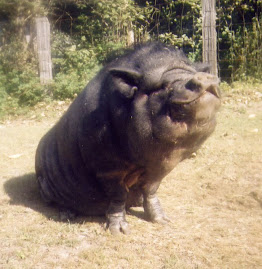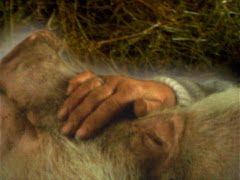
Somewhere in Iowa, AND CANADA a pig is being raised in a confined pen, packed in so tightly with other swine that their curly tails have been chopped off so they won't bite one another. To prevent him from getting sick in such close quarters, he is dosed with antibiotics. The waste produced by the pig and his thousands of pen mates on the factory farm where they live goes into manure lagoons that blanket neighboring communities with air pollution and a stomach-churning stench. He's fed on American corn that was grown with the help of government subsidies and millions of tons of chemical fertilizer. When the pig is slaughtered, at about 5 months of age, he'll become sausage or bacon that will sell cheap, feeding an American addiction to meat that has contributed to an obesity epidemic currently afflicting more than two-thirds of the population. And when the rains come, the excess fertilizer that coaxed so much corn from the ground will be washed into the Mississippi River and down into the Gulf of Mexico, where it will help kill fish for miles and miles around. That's the state of your bacon — circa 2009.
(See TIME's photo-essay "From Farm to Fork.")
Horror stories about the food industry have long been with us — ever since 1906, when Upton Sinclair's landmark novel The Jungle told some ugly truths about how America produces its meat. In the century that followed, things got much better, and in some ways much worse. The U.S. agricultural industry can now produce unlimited quantities of meat and grains at remarkably cheap prices. But it does so at a high cost to the environment, animals and humans. Those hidden prices are the creeping erosion of our fertile farmland, cages for egg-laying chickens so packed that the birds can't even raise their wings and the scary rise of antibiotic-resistant bacteria among farm animals. Add to the price tag the acceleration of global warming — our energy-intensive food system uses 19% of U.S. fossil fuels, more than any other sector of the economy.
And perhaps worst of all, our food is increasingly bad for us, even dangerous. A series of recalls involving contaminated foods this year — including an outbreak of salmonella from tainted peanuts that killed at least eight people and sickened 600 — has consumers rightly worried about the safety of their meals. A food system — from seed to 7‑Eleven — that generates cheap, filling food at the literal expense of healthier produce is also a principal cause of America's obesity epidemic. At a time when the nation is close to a civil war over health-care reform, obesity adds $147 billion a year to our doctor bills. "The way we farm now is destructive of the soil, the environment and us," says Doug Gurian-Sherman, a senior scientist with the food and environment program at the Union of Concerned Scientists (UCS).
(See pictures of what the world eats.)
Some Americans are heeding such warnings and working to transform the way the country eats — ranchers and farmers who are raising sustainable food in ways that don't bankrupt the earth. Documentaries like the scathing Food Inc. and the work of investigative journalists like Eric Schlosser and Michael Pollan are reprising Sinclair's work, awakening a sleeping public to the uncomfortable realities of how we eat. Change is also coming from the very top. First Lady Michelle Obama's White House garden has so far yielded more than 225 lb. of organic produce — and tons of powerful symbolism. But hers is still a losing battle. Despite increasing public awareness, sustainable agriculture, while the fastest-growing sector of the food industry, remains a tiny enterprise: according to the most recent data from the U.S. Department of Agriculture (USDA), less than 1% of American cropland is farmed organically. Sustainable food is also pricier than conventional food and harder to find. And while large companies like General Mills have opened organic divisions, purists worry that the very definition of sustainability will be co-opted as a result.
(See pictures of urban farming around the world.)
But we don't have the luxury of philosophizing about food. With the exhaustion of the soil, the impact of global warming and the inevitably rising price of oil — which will affect everything from fertilizer to supermarket electricity bills — our industrial style of food production will end sooner or later. As the developing world grows richer, hundreds of millions of people will want to shift to the same calorie-heavy, protein-rich diet that has made Americans so unhealthy — demand for meat and poultry worldwide is set to rise 25% by 2015 — but the earth can no longer deliver. Unless Americans radically rethink the way they grow and consume food, they face a future of eroded farmland, hollowed-out countryside, scarier germs, higher health costs — and bland taste. Sustainable food has an élitist reputation, but each of us depends on the soil, animals and plants — and as every farmer knows, if you don't take care of your land, it can't take care of you.







5 comments:
i had read that article earlier, it is producing quite a stir. its something my husband and i talk about a lot, how can America well any place do this to themselves and expect it to last forever.so that book the jungle, have you read it? i dont need to read anymore or see any more videos or stories, i know enough to change the way i think and eat already, but to think that in 1906 there was already such abuse going on in mass marketing. ??? awful. everytime i see our little pig getting comfy (usually on me) and then sighing a pig sigh i hurt inside for the ones that will never have a single good day in their short life, not one! and they keep on going, they still want to live. its what i remember when life gets hard for me
Love the addition of "and Canada" here!
I read this entire post and afterwards found an article about 4H of which I know nothing. So I read that too, thinking this is a program for kids to learn about animals and how to take care of them and how to be responsible for them.
Imagine my horror when I found out that after their animal wins a ribbon the kids get money according the weight of the animals (they go per pound?)
The comment of one little boy who had taken care of a pig and who said the pig really liked him, was that he'd get another animal. As if it's no big deal.
I cried, literally balled over this story. After reading your blog and others of how intelligent these gorgeous animals are and now trusting and loving and how they bond, this 4H thing is beyond disgusting to me!
YUCK!
Yes, I blogged about this very topic when we were at a little even here. ;o((((((((((((((
replace the word 'even' with 'fair" I have no idea what i was doing there. .
Post a Comment